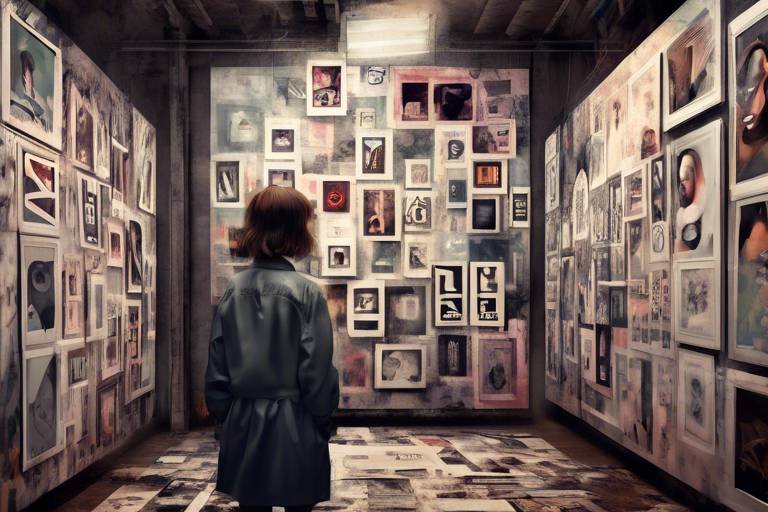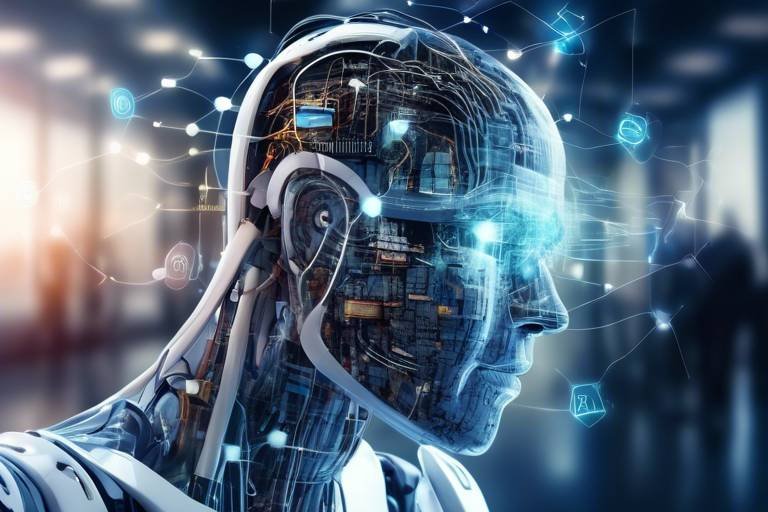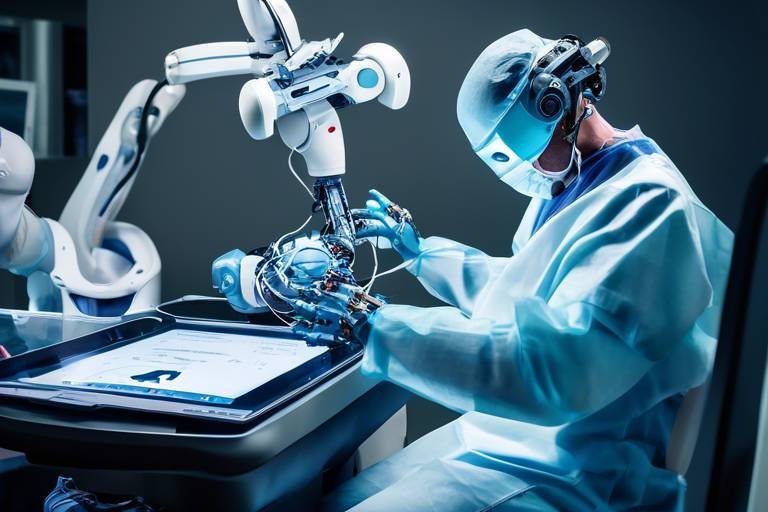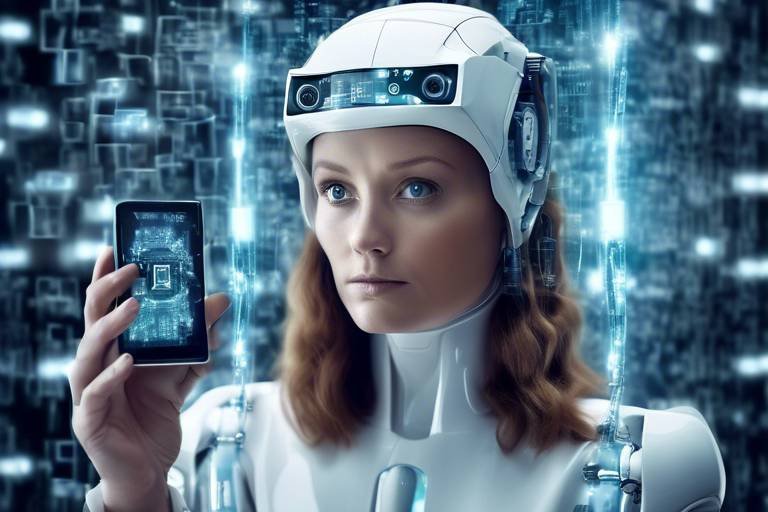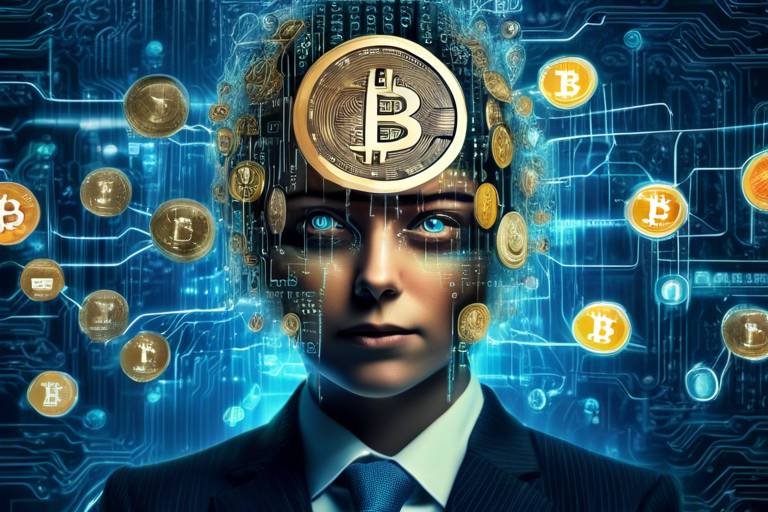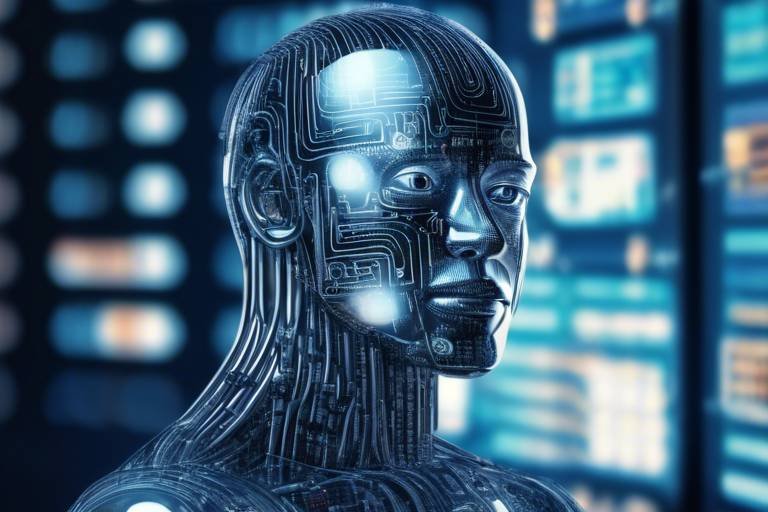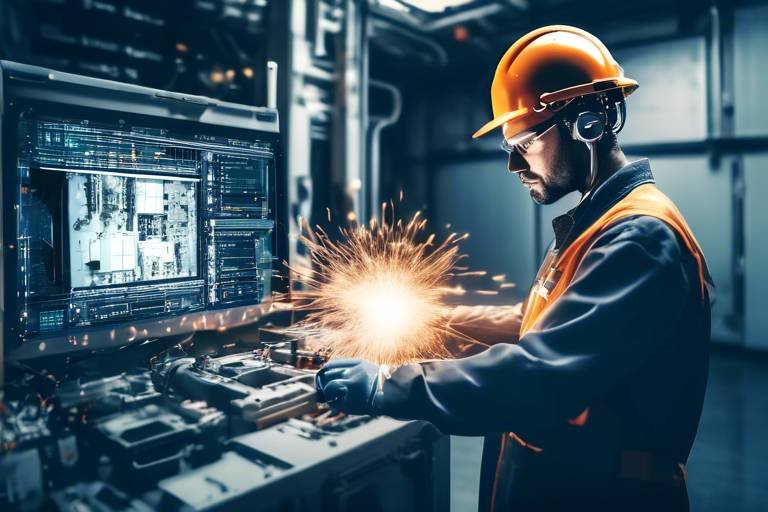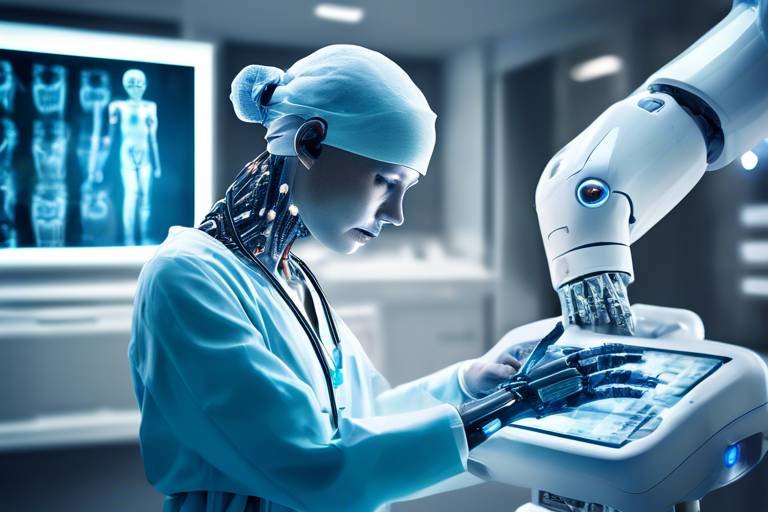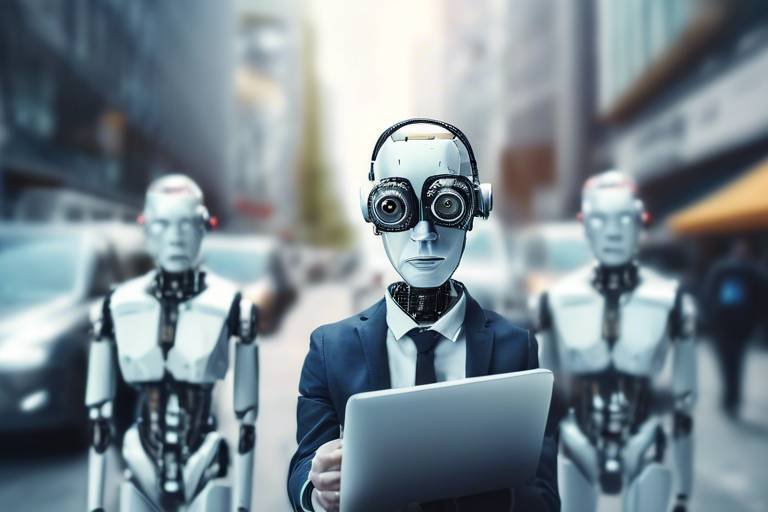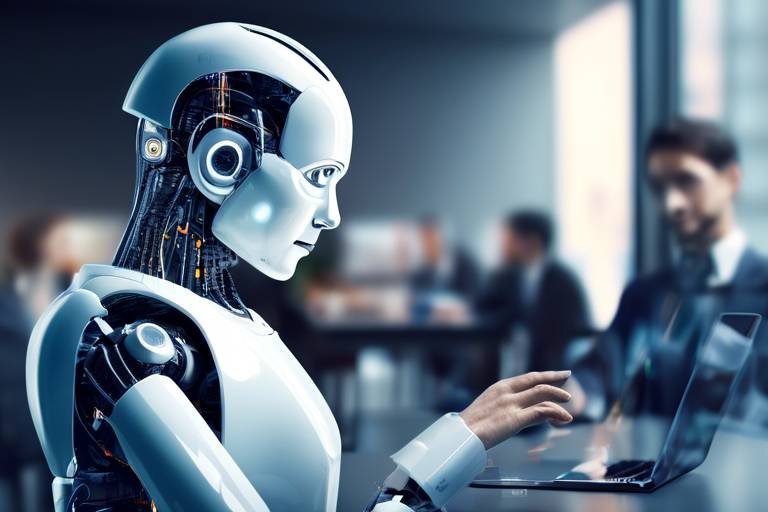AI's Unseen Influence on Art and Creativity
The world of art is undergoing a dramatic transformation, and at the heart of this evolution is artificial intelligence (AI). Gone are the days when creativity was solely a human endeavor; now, AI is stepping into the spotlight, reshaping how we create, perceive, and appreciate art. But what does this mean for artists and art lovers alike? In this article, we will explore the transformative role of AI in the art world, examining how it shapes creativity, influences artists, and redefines the boundaries of artistic expression.
To understand AI's impact on art, we must first look at its historical development. The journey began in the mid-20th century, with early experiments in computer-generated art. Fast forward to today, and AI technologies have advanced tremendously, leading to significant milestones that have shaped the current landscape of artistic creation. From the first algorithmic art pieces to the sophisticated machine learning models we see now, AI has evolved into a vital tool for artists. Key milestones include:
- The invention of the first computer art programs in the 1960s.
- The emergence of generative art in the 1980s.
- Recent advancements in deep learning and neural networks.
These developments have not only enhanced artistic capabilities but have also opened up new avenues for collaboration between artists and machines, leading to a renaissance of creativity that blends human intuition with computational power.
Today, artists are increasingly viewing AI as a creative partner rather than just a tool. This collaboration allows for the exploration of new techniques and styles that challenge traditional artistic boundaries. Imagine an artist sitting next to a computer, not as a mere operator but as a co-creator, exchanging ideas and inspirations. This dynamic interaction is where the magic happens!
Algorithms play a crucial role in this creative partnership. They function as creative tools, enabling artists to generate unique pieces that blend human intuition with the analytical prowess of machines. For instance, algorithms can analyze vast datasets of existing artworks, identifying patterns and styles that the artist may not have considered. This fusion of human and machine creativity leads to innovative artworks that push the envelope of what art can be.
One of the most exciting aspects of AI in art is the rise of generative art techniques. Artists use algorithms to create intricate designs and compositions that are often unexpected and mesmerizing. These techniques allow for a level of complexity and detail that would be nearly impossible to achieve by hand. For example, generative art can create:
- Dynamic visuals that change over time.
- Complex patterns based on mathematical principles.
- Interactive pieces that respond to viewer input.
By harnessing the capabilities of machine learning, artists are crafting stunning pieces that challenge our understanding of creativity.
Another fascinating application of AI in art is found in interactive installations. These artworks engage the audience in real-time, allowing viewers to influence the experience through their actions. Imagine walking into a gallery where your movements alter the visuals or sounds around you. This dynamism creates a unique interplay between the viewer and the artwork, transforming passive observation into an active participatory experience.
As AI continues to evolve, its role in art critique is also emerging. Machine learning algorithms can evaluate art based on various criteria, providing insights that complement human perspectives. This new form of critique challenges traditional notions of expertise and opens the door to diverse interpretations. Artists can gain valuable feedback, helping them refine their work and explore new directions.
With the rise of AI, traditional artists are facing both challenges and opportunities. Some may feel threatened by the technology, fearing it will replace their creative roles. However, many are embracing AI as a new tool to enhance their artistic practices. The key lies in adapting to new tools while maintaining their unique voices and visions.
Artists are learning to integrate AI into their workflows, using it to streamline processes and inspire new ideas. This adaptation requires a willingness to experiment and explore uncharted territories. By leveraging AI, artists can focus more on the creative aspects of their work, while the technology handles repetitive tasks. This synergy can lead to a more enriching creative experience.
AI is also influencing contemporary artistic styles, leading to the emergence of new genres that reflect the intersection of technology and creativity. Artists are now able to explore styles that blend traditional techniques with digital innovations, resulting in a rich tapestry of artistic expression. The future of art is not just about the artist; it's about the collaboration between human creativity and artificial intelligence.
As we embrace the potential of AI in art, we must also address the ethical implications. Questions arise regarding authorship and originality. If a machine generates a piece of art, who owns it? Is it the artist who programmed the algorithm, or is it the machine itself? Furthermore, the potential commodification of creative expression in a technology-driven landscape raises concerns about the true value of art. Navigating these ethical waters will be crucial as we move forward into this new era of artistic exploration.
Q: Can AI create art independently?
A: While AI can generate art, it typically requires human input and guidance to create meaningful pieces. AI serves as a tool that enhances human creativity rather than replacing it.
Q: How does AI influence traditional art forms?
A: AI introduces new techniques and tools that artists can incorporate into their work, leading to innovative styles and methods that blend traditional and modern practices.
Q: What are the ethical concerns surrounding AI-generated art?
A: Key concerns include issues of authorship, originality, and the potential commodification of art. These questions challenge our understanding of creativity and ownership in the digital age.
The Evolution of AI in Art
The journey of artificial intelligence (AI) in the realm of art is nothing short of fascinating. It’s like watching a new species evolve right before our eyes, taking shape and adapting in ways that challenge our traditional notions of creativity. The seeds of AI in art were sown back in the 1960s when pioneers began experimenting with algorithms to create visual art. Fast forward to today, and we find ourselves in an era where AI is not just a tool but a collaborator in the creative process.
One of the key milestones in this evolution was the development of neural networks, which mimic the way the human brain processes information. These networks have enabled machines to learn from vast datasets, allowing them to generate art that is not only visually stunning but also conceptually rich. For instance, in 2014, a project called DeepDream by Google showcased how AI could transform images into dream-like visuals, sparking a wave of interest among artists and technologists alike.
As we delve deeper into the timeline of AI's evolution in art, it’s essential to recognize some pivotal moments that have shaped its current landscape:
- 1965: Harold Cohen creates AARON, one of the first AI programs designed to produce art autonomously.
- 2016: The portrait "Edmond de Belamy," generated by a GAN (Generative Adversarial Network), is sold at auction for an astonishing $432,500, signaling AI's acceptance in the art market.
- 2020: AI-generated artworks begin to dominate social media, with artists leveraging platforms like Instagram to showcase their AI collaborations.
These milestones not only highlight the technological advancements but also reflect a growing acceptance of AI as a legitimate player in the art world. Artists are increasingly realizing that AI can serve as a powerful ally, enabling them to push the boundaries of their creativity. The collaboration between human intuition and machine learning has given birth to a new genre of art that is both innovative and thought-provoking.
Moreover, the evolution of AI in art has opened up discussions about the very essence of creativity and authorship. Questions arise such as: Can a machine truly create art? Or is it merely reflecting the data fed into it? These inquiries challenge our understanding of artistic intent and originality, making the evolution of AI in art not just a technological phenomenon but a philosophical one as well.
In summary, the evolution of AI in the art world is a dynamic interplay of technology and creativity, marked by significant milestones that have transformed the landscape of artistic expression. As we continue to explore this intersection, one thing is clear: AI is not just an observer in the art world; it is a transformative force that is reshaping how we create, interpret, and appreciate art.
AI as a Creative Partner
In today's rapidly evolving artistic landscape, the role of artificial intelligence has transcended mere tool usage; it has become an essential creative partner for many artists. Imagine stepping into a studio where your collaborator is not just another human, but a sophisticated algorithm capable of generating ideas, suggesting color palettes, and even creating entire compositions. This relationship is not just a trend—it's reshaping the way art is conceived and executed. Artists are now able to push the boundaries of their creativity, exploring uncharted territories that were previously unimaginable.
The beauty of AI lies in its ability to analyze vast amounts of data and recognize patterns that might elude even the most experienced artists. By leveraging machine learning, artists can harness these insights to enhance their creative processes. For instance, consider an artist who specializes in abstract painting. By utilizing AI algorithms, they can input their previous works and allow the AI to generate variations that maintain their unique style while introducing unexpected elements. This not only sparks inspiration but also challenges the artist to think outside the box.
Moreover, AI's role as a creative partner extends beyond mere suggestion and into the realm of collaboration. Artists are increasingly engaging with AI to create dynamic, generative art. This form of art evolves in real-time, influenced by external data such as weather patterns, social media trends, or even audience interactions. For example, an artist might create an installation that changes its visual output based on the emotions of its viewers, as interpreted by AI. This creates a dynamic interplay between the artwork and its audience, making each experience unique and personal.
Another fascinating aspect of AI as a creative partner is its ability to assist in the technical aspects of art creation. Many artists struggle with the mechanical side of their craft—whether it's mastering complex software or perfecting intricate techniques. Here, AI can step in as a supportive ally. With AI-driven tools, artists can automate repetitive tasks, allowing them to focus more on the creative aspects of their work. For instance, a digital artist might use AI to generate background textures or to refine their sketches, thus freeing up time for more conceptual thinking.
While the collaboration between artists and AI opens up a world of possibilities, it also raises intriguing questions about authorship and originality. If an AI generates a piece of art, who is the true creator? Is it the artist who provided the input, or the algorithm that executed the idea? These questions are at the forefront of discussions surrounding AI in art, prompting artists and critics alike to rethink traditional notions of creativity and ownership.
In conclusion, the integration of AI into the artistic process is not just a passing phase; it represents a profound shift in how we understand and engage with creativity. As artists continue to explore this partnership, we can expect to see an explosion of innovative works that challenge our perceptions and redefine the boundaries of artistic expression.
- How does AI enhance creativity in art? AI enhances creativity by providing new perspectives, generating variations of existing works, and automating tedious tasks, allowing artists to focus more on their creative vision.
- Can AI create original art? Yes, AI can create original art, but the question of authorship remains complex. The collaboration between the artist and the AI plays a crucial role in defining the originality of the work.
- What are some examples of AI in art? Examples include generative art installations that change based on audience interaction, AI-assisted painting tools, and applications that analyze and suggest artistic styles.
The Role of Algorithms
Algorithms have become the unsung heroes in the world of art, acting as a bridge between human creativity and computational precision. Think of them as the invisible paintbrushes that artists wield, allowing them to explore uncharted territories of artistic expression. By leveraging algorithms, artists can tap into a wellspring of possibilities that were previously unimaginable. These mathematical formulas and processes can analyze vast amounts of data, recognize patterns, and even generate new ideas, transforming the creative landscape.
One fascinating aspect of algorithms is their ability to assist in the exploration of new techniques. For instance, artists can input specific parameters into an algorithm, which then generates a multitude of variations based on those inputs. This process can yield unexpected results, often leading to groundbreaking artworks that challenge conventional boundaries. Imagine an artist who wants to create a piece inspired by nature; by using an algorithm, they can generate countless iterations of a landscape, each one unique and compelling in its own right.
Moreover, algorithms enable artists to blend their intuition with computational power, resulting in a harmonious fusion of creativity and technology. This synergy allows for the creation of unique pieces that resonate with audiences on multiple levels. For example, an artist might use an algorithm to create a dynamic visual experience that changes in real-time based on viewer interactions. This not only enhances the artwork but also engages the audience in a way that traditional art forms often cannot.
To illustrate the impact of algorithms in art, consider the following table that highlights some key areas where algorithms are making waves:
| Application | Description |
|---|---|
| Generative Design | Algorithms create designs based on parameters set by the artist, leading to innovative and unexpected results. |
| Data Visualization | Using algorithms to transform complex data sets into visually engaging artworks that tell a story. |
| Style Transfer | Algorithms can apply the style of one artwork to the content of another, creating new interpretations of classic pieces. |
In essence, algorithms serve as a powerful tool for artists, enabling them to push the boundaries of what is possible in the realm of creativity. They offer a new lens through which to view the artistic process, inviting artists to experiment, innovate, and redefine their craft. As we witness the evolution of art in the digital age, it becomes increasingly clear that algorithms are not just tools; they are collaborators in the creative journey.
Generative Art Techniques
Generative art techniques represent a fascinating intersection of technology and creativity, where artists leverage algorithms and code to produce stunning visual works. Imagine a world where your canvas is not just a piece of paper but a dynamic system that evolves over time, responding to various inputs and parameters. This is the essence of generative art—art that is not merely created but is alive in its own right.
At the heart of generative art lies the concept of algorithmic design. Artists write code that dictates how shapes, colors, and patterns interact, often leading to unexpected and mesmerizing outcomes. This process can be likened to planting seeds in a garden; the artist sets the conditions, but the final bloom can be a delightful surprise. Some popular generative art techniques include:
- Fractal Generation: Artists use mathematical algorithms to create intricate, self-replicating patterns that can be infinitely zoomed into, revealing stunning details.
- Particle Systems: This technique simulates the movement of particles, allowing artists to create dynamic visuals that mimic natural phenomena like fire, smoke, or flocking birds.
- Cellular Automata: By defining simple rules for how cells interact on a grid, artists can generate complex patterns that evolve over time, reminiscent of life itself.
These techniques not only expand the toolkit available to artists but also invite audiences to engage with the artwork in novel ways. For instance, some generative pieces can change based on real-time data inputs, such as weather conditions or social media trends. This interactivity transforms the viewer from a passive observer into an active participant, creating a unique experience every time they encounter the artwork.
Furthermore, the use of machine learning in generative art is opening new frontiers. Artists can train algorithms on vast datasets to produce works that reflect specific styles or themes. Imagine an artist teaching a computer to mimic the brushstrokes of Van Gogh or the color palettes of Monet. The results can be astonishing, blending the artist's vision with the computational prowess of AI.
As generative art continues to evolve, it challenges our perceptions of authorship and creativity. Who is the true creator—the artist who designed the algorithm or the algorithm itself? This question invites deep philosophical discussions about the nature of art and the role of technology in shaping our creative landscapes.
In conclusion, generative art techniques are not just tools; they are a new language of expression that enriches the artistic dialogue. As artists continue to explore these methods, they are pushing the boundaries of what art can be, inviting us all to rethink our understanding of creativity in the digital age.
Q1: What is generative art?
Generative art is a form of art that is created through the use of algorithms and code, allowing for dynamic and often unpredictable outcomes. Artists set parameters, and the artwork evolves based on these inputs.
Q2: How do artists use algorithms in their work?
Artists use algorithms to dictate the rules of creation, enabling them to produce complex patterns, shapes, and colors that might be difficult to achieve by hand. This allows for a blend of human creativity and computational power.
Q3: What are some examples of generative art techniques?
Some common techniques include fractal generation, particle systems, and cellular automata, each offering unique ways to create intricate and evolving artworks.
Q4: Can generative art be interactive?
Yes! Many generative artworks are designed to react to real-time data or audience interactions, creating a unique experience for each viewer.
Interactive Installations
Interactive installations are revolutionizing the way we experience art, blending the physical and digital realms in ways that were previously unimaginable. Imagine walking into a gallery where the artwork responds to your movements, emotions, or even the sounds you make. This is not just a dream; it’s the reality created by the synergy of artificial intelligence and artistic expression. These installations invite viewers to become active participants rather than passive observers, transforming the entire concept of art appreciation.
At the heart of many interactive installations lies sophisticated AI algorithms that analyze real-time data from the audience. This data can include anything from facial expressions to body movements, allowing the artwork to adapt dynamically. For instance, an installation might change colors, shapes, or sounds based on the number of people present, their emotional states, or the time of day. This creates a unique experience for each visitor, as no two interactions will ever be the same.
One fascinating example of this is the work of artists like Rafael Lozano-Hemmer, who creates immersive environments where the audience's presence directly influences the artwork. In his piece "33 Questions per Minute," visitors can engage with a constantly evolving narrative that is shaped by their interactions. This kind of engagement not only captivates the audience but also prompts them to reflect on their relationship with technology and art.
Moreover, interactive installations often incorporate elements of gamification, making the experience even more engaging. Visitors might find themselves solving puzzles or completing tasks that unlock new dimensions of the artwork. This interactivity fosters a sense of community as people share their experiences and collaborate to explore the installation together. It’s like stepping into a living, breathing artwork that evolves with every interaction.
As we look to the future, the potential for interactive installations powered by AI seems limitless. Artists are continually pushing the boundaries, experimenting with new technologies such as virtual reality (VR) and augmented reality (AR), to create even more immersive experiences. These advancements not only enhance the viewer's experience but also challenge traditional notions of what art can be. The lines between artist, audience, and artwork blur, creating a collaborative environment where creativity thrives.
In conclusion, interactive installations represent a thrilling frontier in the art world, where AI serves as both a tool and a collaborator. They invite us to engage with art in ways that provoke thought, inspire creativity, and foster connection. As technology continues to evolve, we can only imagine the extraordinary experiences that await us in the realm of interactive art.
AI-Driven Art Critique
As we dive deeper into the realm of AI, one of the most fascinating developments is its role in art critique. Traditionally, art critique has been a subjective process, heavily reliant on human perception, emotions, and cultural context. However, with the advent of machine learning algorithms, we are witnessing a shift that could redefine how we evaluate and appreciate art. Imagine a world where an algorithm can analyze a painting and provide insights that are not only based on aesthetic principles but also on data-driven analysis of styles, techniques, and historical context. This is not science fiction; it’s happening now.
AI systems can process vast amounts of data at lightning speed, making them capable of identifying patterns that may elude even the most seasoned art critics. For instance, an AI could analyze thousands of artworks to determine common themes, color palettes, and compositional techniques used by various artists throughout history. This capability allows for a more comprehensive critique, one that combines both qualitative and quantitative assessments. But how does this actually work? Let's break it down:
- Data Collection: The first step involves gathering a large dataset of artworks, which can include images, descriptions, and critiques.
- Training the Algorithm: Using this data, machine learning models are trained to recognize different styles, techniques, and even emotional responses elicited by various artworks.
- Analysis and Insights: Once trained, the AI can analyze new pieces and provide feedback based on its learned understanding, offering insights that might include technical flaws, thematic depth, or even market trends.
One of the most intriguing aspects of AI-driven art critique is its potential to democratize art evaluation. With algorithms capable of providing insights that were once reserved for elite critics, emerging artists can receive feedback that is objective, constructive, and accessible. This could lead to a more inclusive art world where diverse voices are heard and valued. However, it also raises questions about the role of human critics and the essence of artistic value. Can an algorithm truly understand the emotional weight behind a piece, or will it forever be limited to the data it processes?
Moreover, the integration of AI in art critique has sparked a debate about authenticity and originality. As algorithms begin to influence how we perceive art, we must ask ourselves: does the opinion of an AI hold the same weight as that of a human? This question is particularly relevant in a world where art is increasingly being created in collaboration with AI. If an algorithm can critique a piece, does that make it a co-creator? The lines between creator and critic are blurring, and this could lead to a new era of artistic expression.
In conclusion, while AI-driven art critique offers exciting possibilities, it also presents challenges that the art community must navigate carefully. The balance between human intuition and machine analysis is delicate, and finding harmony in this relationship will be key to the future of art critique. As we embrace these new technologies, it’s essential to remember that at the heart of art lies the human experience—something that, for now, remains irreplaceable.
The Impact on Traditional Artists
As the digital landscape evolves, traditional artists find themselves at a crossroads, faced with both challenges and opportunities brought about by the rise of artificial intelligence in the art world. The emergence of AI tools has sparked a significant debate among artists regarding the authenticity of their work and the essence of creativity itself. Some artists view AI as a threat, fearing that it might overshadow their skills and techniques, while others embrace it as a new medium that can elevate their artistic expression to uncharted territories.
One of the primary challenges traditional artists encounter is the need to adapt to new technologies. Many artists have spent years honing their craft, mastering techniques that have been passed down through generations. Now, they are confronted with the necessity to learn how to integrate AI tools into their creative processes. This transition can feel daunting, akin to learning a new language; however, it also offers a chance for growth and innovation. Artists who embrace AI can discover new ways to express their visions, pushing the boundaries of their creativity.
Moreover, AI has the potential to influence artistic styles significantly. As algorithms create art that is distinctly different from traditional methods, artists may find themselves inspired by these new forms. The fusion of human creativity with AI-generated elements can lead to the emergence of entirely new genres, reshaping the art landscape. For example, artists might combine their traditional techniques with AI-generated visuals, resulting in a hybrid style that reflects both human emotion and machine precision.
Furthermore, many traditional artists are beginning to see AI not just as a tool, but as a collaborative partner. By utilizing AI algorithms, artists can explore creative avenues they may not have considered before. This collaboration can manifest in various ways, from using AI to generate initial concepts that the artist then refines, to creating interactive pieces where the AI adapts to audience reactions in real-time. This dynamic interplay between human intuition and machine learning can lead to astonishing results, captivating audiences and challenging preconceived notions about art.
Despite the many advantages, the integration of AI in art raises questions about the essence of authorship and originality. As artists navigate this new terrain, they must grapple with the implications of AI-generated works. Who is the true creator when a piece is the result of both human and machine input? This dilemma can lead to a sense of uncertainty, as artists strive to maintain their unique voices while exploring the possibilities that AI offers. To address these concerns, artists are encouraged to engage in open discussions about authorship and the evolving nature of creativity in the digital age.
In conclusion, the impact of AI on traditional artists is profound and multifaceted. While the challenges of adapting to new technologies and navigating ethical dilemmas are significant, the opportunities for innovation and collaboration are equally compelling. As artists continue to explore the intersection of technology and creativity, they will undoubtedly redefine what it means to be an artist in the 21st century.
- How can traditional artists benefit from using AI? Traditional artists can enhance their creative processes, explore new styles, and collaborate with AI to create innovative artworks.
- Does AI replace the need for traditional artistic skills? No, AI serves as a tool that can complement and enhance traditional skills rather than replace them.
- What are the ethical concerns regarding AI in art? Issues of authorship, originality, and the potential commodification of art are significant ethical considerations in the AI art landscape.
Adapting to New Tools
As the art world evolves, traditional artists find themselves at a fascinating crossroads where innovation meets tradition. The emergence of artificial intelligence (AI) tools has not only transformed the way art is created but has also prompted artists to reconsider their own methods and practices. Imagine standing in front of a canvas, paintbrush in hand, while a sophisticated algorithm runs in the background, suggesting color palettes and compositions. It sounds like something out of a sci-fi novel, but this is the reality many artists are embracing today.
Initially, the integration of AI into the artistic process might seem daunting. Artists are accustomed to relying on their intuition, emotions, and personal experiences to guide their work. However, adapting to new tools can open up a world of possibilities. For instance, artists can now explore complex patterns and unique designs that were previously unimaginable. By learning how to use AI software, they can enhance their creativity rather than replace it. This shift can be likened to the introduction of photography in the 19th century—an innovation that sparked debate but ultimately expanded the horizons of artistic expression.
Here are a few ways artists are adapting to these new tools:
- Experimentation: Many artists are treating AI as a collaborative partner, experimenting with its capabilities to generate new ideas. This experimentation allows them to push their creative boundaries.
- Workshops and Learning: Artists are increasingly attending workshops focused on AI technologies. These sessions not only teach them how to use the tools but also foster a community of like-minded creatives who share insights and techniques.
- Integration into Existing Practices: Instead of completely overhauling their methods, many artists are integrating AI tools into their existing workflows. This means using AI for specific tasks, such as generating textures or layouts, while still applying their personal touch to the final product.
Moreover, the use of AI can lead to unexpected outcomes that challenge the artist's perspective. For instance, an artist might input a few lines of code and watch as the AI produces a piece that they would have never thought to create themselves. This kind of collaboration can be exhilarating, as it blends human creativity with machine learning to produce art that is both unique and thought-provoking.
However, adapting to these new tools also raises questions about the artist's identity. Will the essence of the artist be diluted by the influence of AI? Or can technology enhance their unique voice? Artists who embrace AI often find a balance, using it to amplify their message rather than overshadow it. This ongoing dialogue between technology and artistry is crucial, as it shapes the future of creative expression.
In conclusion, as artists adapt to AI tools, they are not just learning to use new technology; they are redefining what it means to be an artist in the 21st century. The journey of adaptation is filled with challenges, but it also offers a thrilling opportunity to explore new frontiers in creativity. By embracing these tools, artists can create works that resonate on deeper levels, inviting audiences into a conversation that spans both human and machine creativity.
Q1: How can AI enhance my artistic practice?
A1: AI can assist in generating ideas, exploring new techniques, and providing feedback on your work, allowing you to push your creative boundaries.
Q2: Do I need technical skills to use AI tools?
A2: While some familiarity with technology can be helpful, many AI tools are designed to be user-friendly and accessible, making it easier for artists to integrate them into their practice.
Q3: Will using AI take away my artistic voice?
A3: Not at all! AI can serve as a collaborative partner, enhancing your unique style and helping you to explore new creative avenues without compromising your artistic identity.
AI's Influence on Artistic Styles
As we stand on the brink of a new era in the art world, it's fascinating to observe how artificial intelligence is reshaping the very fabric of artistic styles. The infusion of AI into the creative process is not just a passing trend; it’s a revolution that has given birth to unique genres and movements, blending technology with traditional forms of expression. Imagine a world where a painter can collaborate with an algorithm to create a piece that is both human and machine-made, resulting in an artwork that challenges our understanding of creativity.
One of the most striking impacts of AI on artistic styles is the emergence of what we can call hybrid art forms. These styles often combine elements from various traditional art movements, enhanced by the precision and innovative capabilities of machine learning. For instance, artists are now experimenting with styles such as AI-generated abstract expressionism, where the chaotic beauty of spontaneous brush strokes is complemented by the algorithmic patterns generated by AI. This fusion creates a dialogue between chaos and order, inviting viewers to interpret the work through multiple lenses.
Moreover, AI has enabled artists to explore new dimensions of creativity that were previously unimaginable. With tools like deep learning and neural networks, artists can analyze vast amounts of data from historical artworks, extracting patterns and styles that can be reinterpreted in contemporary contexts. This not only revitalizes classic styles but also paves the way for entirely new ones. For example, the rise of algorithmic art has led to the creation of pieces that evolve over time, changing with each interaction, thus blurring the lines between static art and dynamic experiences.
In addition, we can see how AI influences the color palettes and composition techniques used by contemporary artists. By utilizing AI tools, artists can generate color schemes that resonate with current trends or evoke specific emotions, allowing for a more nuanced approach to color theory. This capability encourages artists to step outside their comfort zones and experiment with combinations that might have seemed unthinkable just a few years ago. The result? A vibrant tapestry of styles that reflect the complexity of our digital age.
However, this transformation is not without its controversies. As artists embrace AI, the question of authenticity arises. Are these AI-influenced works genuinely original, or are they mere imitations of human creativity? This debate has sparked discussions among critics, collectors, and artists alike, leading to a broader examination of what it means to be an artist in the age of technology.
In summary, AI's influence on artistic styles is profound and multifaceted. It challenges traditional notions of creativity while offering artists new tools to express their visions. As we continue to explore this intersection of art and technology, one thing is clear: the future of art is a collaborative canvas where human intuition meets machine intelligence, creating a rich landscape of possibilities that invites us all to participate in the conversation.
- How is AI changing the way artists create? AI provides artists with new tools and techniques, allowing them to experiment with styles and compositions that were previously difficult to achieve.
- What are some examples of AI-generated art? Examples include algorithmic art, generative design, and AI-enhanced paintings that evolve based on viewer interaction.
- Is AI art considered original? This is a debated topic; while AI can generate unique pieces, the question of authorship and originality remains complex.
- Can AI replace human artists? While AI can assist in the creative process, it lacks the emotional depth and personal experiences that human artists bring to their work.
Ethical Considerations in AI Art
The rise of artificial intelligence in the art world brings with it a plethora of ethical considerations that demand our attention. As AI-generated artworks become more prevalent, questions surrounding authorship, originality, and the commodification of creativity are at the forefront of discussions among artists, critics, and technologists alike. One of the most pressing issues is the question of who truly owns an artwork created with the assistance of AI. Is it the artist who inputs the data and parameters, or is it the algorithm that generates the final piece? This dilemma challenges our traditional understanding of artistic ownership and raises concerns about the implications for copyright laws.
Moreover, the concept of originality is being redefined in this new landscape. When an AI system is trained on existing artworks, it can produce pieces that mimic human creativity but are, in essence, derivative. This leads to a fascinating yet troubling question: can we consider AI-generated art as truly original if it is based on the works of human artists? The line between inspiration and plagiarism becomes increasingly blurred, prompting discussions about the ethical responsibilities of artists who utilize AI in their creative processes.
Another critical aspect to consider is the potential commodification of art in an AI-driven world. As algorithms churn out artworks at an unprecedented rate, the value of individual pieces may diminish, leading to a marketplace flooded with art that lacks the personal touch and emotional depth traditionally associated with human creativity. This shift could fundamentally alter how we perceive art, moving it from a deeply personal expression to a mere product of technological output. In this context, we must ask ourselves: does the accessibility of AI-generated art enhance or detract from the overall appreciation of artistic expression?
To navigate these complex ethical waters, it is essential for artists and technologists to engage in ongoing dialogue about the implications of AI in art. This includes establishing guidelines and frameworks that address issues of authorship, originality, and value. By fostering a collaborative approach, we can ensure that AI serves as a tool for enhancement rather than a replacement for human creativity.
- What are the main ethical concerns regarding AI in art? The primary concerns revolve around authorship, originality, and the potential commodification of creative expression.
- Who owns an artwork created with AI? Ownership can be complex; it may involve the artist who provides input and the algorithm that generates the piece, raising questions about copyright.
- Does AI-generated art lack originality? Many argue that AI art is derivative, as it often relies on existing works for training, leading to debates about inspiration versus plagiarism.
- How might AI change the art market? The influx of AI-generated artworks may flood the market, potentially diminishing the perceived value of individual pieces.
Frequently Asked Questions
- What is the role of AI in the art world?
AI plays a transformative role in the art world by acting as a creative partner for artists. It helps in enhancing their creative processes, enabling them to produce innovative artworks that challenge traditional methods. With the use of algorithms and machine learning, artists can explore new techniques and generate unique pieces that blend human intuition with computational power.
- How do artists collaborate with AI?
Artists collaborate with AI by integrating algorithms into their creative workflows. This partnership allows them to experiment with generative art techniques and create intricate designs. For instance, interactive installations powered by AI can change based on audience engagement, creating a dynamic interplay between the viewer and the artwork.
- What are generative art techniques?
Generative art techniques involve using algorithms to produce artwork. These techniques allow artists to create complex designs and compositions that would be difficult to achieve through traditional methods. By harnessing the capabilities of machine learning, artists can explore new artistic avenues and push the boundaries of creativity.
- Can AI evaluate art?
Yes, AI can evaluate art using machine learning algorithms. These algorithms can analyze various elements of artwork and provide insights that complement human perspectives. This emerging role of AI in art critique opens up new discussions about the nature of artistic evaluation and appreciation.
- How are traditional artists responding to AI?
Traditional artists are adapting to the rise of AI by learning to integrate these new tools into their creative practices. While some may feel challenged by the technology, many see it as an opportunity to enhance their artistic voices and explore new styles that reflect the intersection of technology and creativity.
- What ethical considerations arise from AI in art?
The integration of AI in art raises several ethical considerations, including issues of authorship and originality. As AI-generated artworks become more prevalent, questions about the commodification of creative expression and the implications for artists' rights and recognition are increasingly important to address.

